If properly stored smokeless powder and primers will last a lifetime and beyond. It is designed to be inherently stable and function predictably after many years of storage and harsh field conditions. This is not to say that you should treat your powder this way, however; the prominent manufacturers have very high standards to appeal to military and civilian usage.
Primer lifetime is so much longer than that of gunpowder that when I asked an insensitive munitions expert what is the expected lifetime of primers, he said “essentially indefinite”.
However, gunpowder has a much more limited shelf life. This is a high energy compound that is breaking down, from day one, to a low energy compound. Our gunpowders are either nitrocellulose or nitrocellulose & nitroglycerine. The nitroglycerine is there basically for the energy boast. Because nitroglycerine attacks the double bonds on nitrocellulose the lifetime of double based powders is less than half that of single based. Stabilizers are mixed with the nitrocellulose/nitroglycerine as a sacrificial compound: stabilizers soak up the nitric acid gas that is created when nitrocellulose deteriorates. When the stabilizer gets low , gunpowder is extremely unstable and unsafe. In quantity it will auto combust and the burn rate is irregular. Burn rate instability has and will blow up firearms.
A good rule of thumb is that single base powders will last 45 years and double based 20 years. Like all rules of thumb this is wrong more often than it is right.
This thread has really excellent pictures:
Has anyone else had Vihtavuori N140 corrode in loaded ammo?
http://www.falfiles.com/forums/showthread.php?p=3745264
Notice that the gunpowder is only around 25 years old and yet people are experiencing nasty corrosion due to nitric acid gas release from the gunpowder. It was not that long ago that 20 years was considered the shelf life of gunpowder.
Army Ordnance Magazine, May 1931, Safety Hazards, Picatinny Arsenal
Smokeless powder constitutes one of the greatest hazards from a storage standpoint, due to the fact that is subject to deterioration and at the best cannot be expected to have a life greater than about twenty years
The worst enemy of gunpowder is heat. The lifetime of gunpowder is reduced exponentially with increases in temperature. This chart came from a UN manual on ammunition inspection. Section 7.3 is well worth reading
Surveillance and in-service proof - the United Nations
http://www.un.org/disarmament/convar...Proof(V.1).pdf
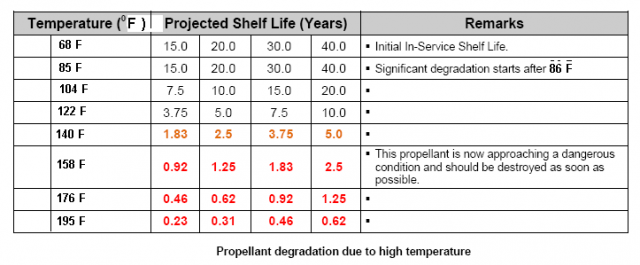
Exposure to water is bad, even though water is a polar covalent molecule, it acts ionic. All ionic compounds break gunpowder down faster. I think that may be a reason why gunpowder now comes in plastic cans, the tin cans released rust into the powder and that accelerated powder breakdown. Water is in air, so it is best to keep gunpowder cans sealed.
Federal says their ammunition has a ten year shelf life:
Federal Ammunition :
http://www.federalpremium.com/company/faq.aspx
What is the shelf life of ammo and storage?
Store reloading components and ammunition in a cool, dry place, protected from direct exposure to sunlight. If stored properly there is a 10-year shelf life on loaded ammunition.
There is very little information on the internet about gunpowder aging and causing pressure problems because all that was ever needed to be known was determined well before WW2. However ball powders did come out at the end of WW2 and I was able to find this data showing that gunpowder at the end of its lifetime will pressure spike. Heat is used to accelerate the age of gunpowder, so what you are seeing is in fact because of “age”, not heat, but it took heat to age the powder quickly. The IMR is a single based and the WC is a double based ball powder.
INVESTIGATION OF THE BALLISTIC AND CHEMICAL STABILITY OF 7.62MM AMMUNITION LOADED WITH BALL AND IMR PROPELLANT
Frankfort Arsenal 1962
3. Effects of Accelerated Storage Propellant and Primer Performance
To determine the effect of accelerated isothermal storage upon propellant and primer performance, sixty cartridges from each of lots E (WC 846) and G (R 1475) were removed from 150F storage after 26 and 42 weeks, respectively. The bullets were then removed from half the cartridges of each lot and from an equal number of each lot previously stored at 70F. The propellants were then interchanged, the bullets re-inserted, and the cases recrimped. Thus, four variations of stored components were obtained with each lot.
Chamber pressures yielded by ammunition incorporating these four variations were as follows. These values represent averages of 20 firings.
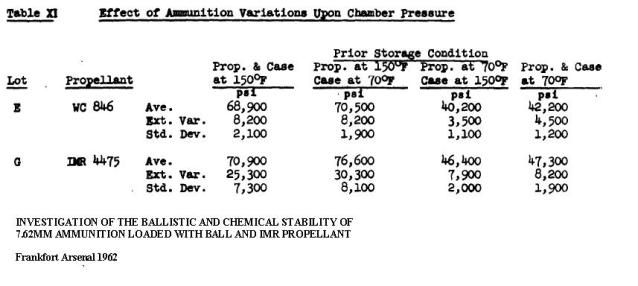
You can google “surplus ammunition Kaboom” or the equivalent and find a surprising number of reports of firearms that have blown up with old military ammunition. Now I am going to tell you the terrible truth about surplus ammunition. The stuff was surplused because it was at the end of its service life and the Army that owned it, determined that it was unsafe to store and unsafe to shoot. Some Ammunition Specialist went through that lot and found evidence that the gunpowder had deteriorated and the stuff was sold to eager Americans who do not know about the risks of old ammunition.
Why some powder goes bad quickly and other lasts longer, heck if I know. The strangeness of this can be found in this thread at Post 61. This is Unclenick’s experience and it is worth looking at the picture:
http://thefiringline.com/forums/showthread.php?t=539440&highlight=old+gunpowder&page=3
Of particular interest to me was the link to the thread on N140. In the early 1990's, my dad got a 1/4 lb free sample container of N140 at Camp Perry, and gave half of it to me. That's about 20 rounds worth in .308; not enough to do serious load development with. I put it in a plastic bottle with a plated and painted steel cap with cardboard seal disc. I left it at the back of a high shelf in the basement where it was out of sight and soon out of mind. Some time later I bought a full pound of N140 to experiment with, but that original 1/4 lb continued to sit.
I finally re-encountered the bottle during some cleaning out activity. It looked like this:
The powder in it was not powder any longer. The grains were all stuck together. That was the result of the lid seal failing and letting humidity in. The acid fumes corroded the lid out. Rinse water put over it poured out yellow. At that point I cut the container open and buried the wet mass under the compost heap to let nature take its course.
Interestingly, the remaining 1/8 lb still at my father's place (also untouched)
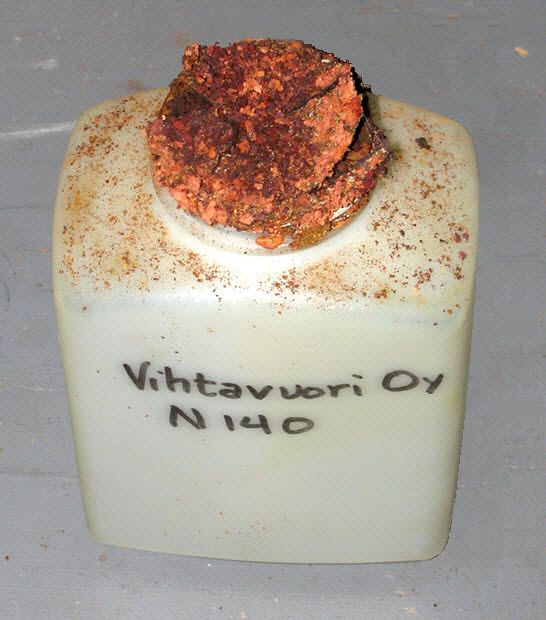
Excellent pictures at this thread:
Corrosion like I have never seen
http://thefiringline.com/forums/showthread.php?t=542632
I inherited a bit of ammo when my Father died, and among that cache was a box of Norma 220gr .30-06 (from the 60's by the look of the box)...
I pulled them out to look at them this AM, and this is what I found:
Five out of 16 rounds have this corrosion on them...On two, the corrosion has expanded the case below the bullet to the extent where the brass ruptured...This box was stored bullet down for decades at Dad's, and for a few years now here...They had a cardboard divider in the box so none touched, and there is no sign of water damage to the box or divider...I have looked through the rest of the 06 ammo boxes, and all are pristine like they came from the factories yesterday (but none are Norma)...
What the heck am I seeing here?
Is this corrosive primers gone bad and dripped through the powder to the base of the bullet and then eaten through, or is this deteriorating powder fuming through the case?
I obviously am not going to fire any of these rounds, but are they even safe to subject to bullet pulling in an impact puller???
I'd love to salvage the bullets at least...
Any help or opinions would be appreciated
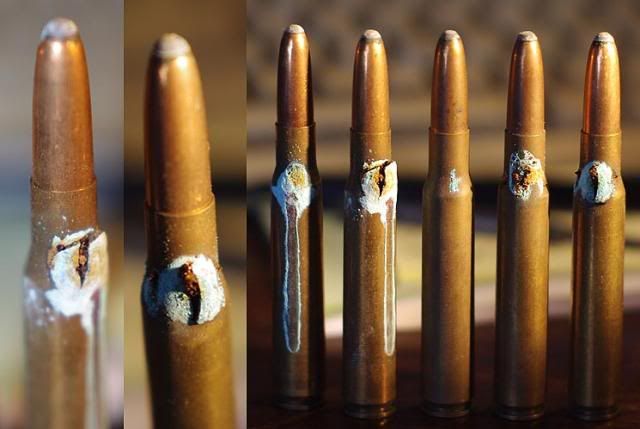
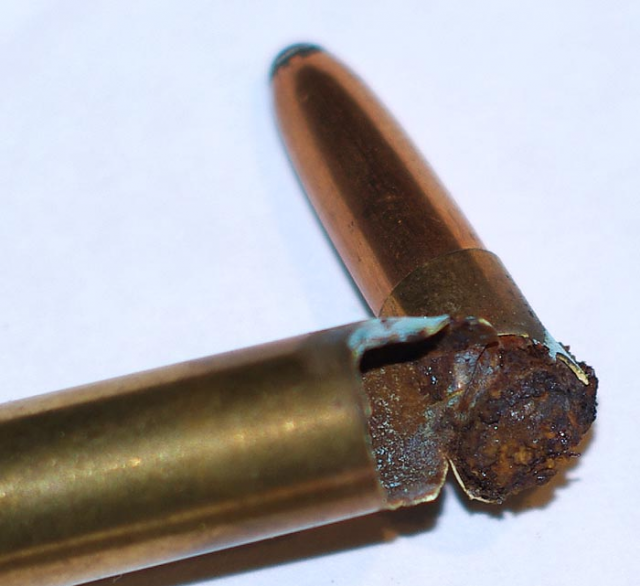
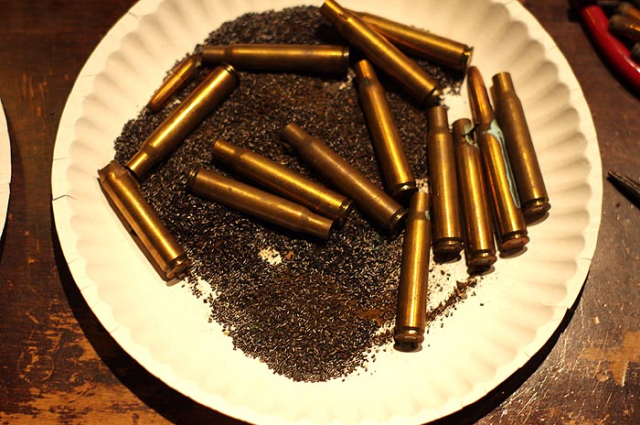
Sure there are people shooting old as heck gunpowder, their guns have not blown up, proves that they are very lucky. There are drunks speeding somewhere in the US, driving old cars with worn out brakes and bald tires and they think they are safe drivers because they got home without an accident. Shoot enough old ammunition and you will win the Kaboom lottery.
So to summarize, powder does not get better with age, heat ages powder fast, old gunpowder will blow up your firearm. Anyone with a $100,000 dollar irreplaceable machine gun should seriously consider the practice of shooting cheap surplus military ammunition. Machine gunners shoot orders of magnitude more ammunition than most people, so as they are burning through a pallet of surplus ammunition, they are more likely to find that statistically improbable bad round. A machine gunner bud of mine told me he had “blown the top cover twice” with 50’s Yugo 8mm. After I told him about pressures and old ammunition, he said it all made sense. If however, that cheap surplus ammunition had wrecked the registered part of the machine gun, his machine gun would have been a total loss. The BATF is not your friend in this matter as the policy of the Federal Government is to reduce the number of machine guns in the hands of the public. You blow yours up, guess what, that is considered a good thing, and you have to find another to replace the one you destroyed.








